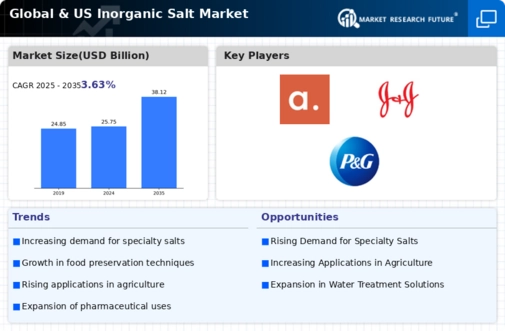Top Industry Leaders in the US Inorganic Salt Market

The global and US inorganic salt market is a vast and dynamic landscape, fueled by the ubiquitous applications of these versatile compounds across various industries. It's a market brimming with opportunities and fierce competition. Let's delve into this intricate ecosystem, exploring the strategies, players, and trends shaping its future.
Strategies Adopted by Market Leaders:
- Product Diversification: Major players like Solvay, Lanxess, and FMC Corporation are expanding their portfolios beyond traditional salts like chlorides and sulfates. They are venturing into specialty salts with higher margins and cater to niche applications in pharmaceuticals, electronics, and water treatment.
- Vertical Integration: Companies are strengthening control over the supply chain by acquiring mines and salt processing facilities. This ensures secure raw material access, cost control, and improved responsiveness to market fluctuations.
- Technological Advancements: Research and development are focused on sustainable production processes, energy efficiency, and novel salt purification methods. Companies like Tata Chemicals and K+S Aktiengesellschaft are investing in green technologies to minimize environmental impact and comply with stricter regulations.
- Geographical Expansion: Emerging economies like China, India, and Brazil present a lucrative growth potential. Established players are setting up production facilities or entering into strategic partnerships in these regions to capitalize on the rising demand.
- Focus on Sustainability: The increasing consumer and regulatory emphasis on sustainability is pushing companies to adopt eco-friendly practices. This includes using recycled materials, reducing water consumption, and developing biodegradable salts.
Factors Influencing Market Share:
- Production Capacity and Efficiency: Companies with efficient and large-scale production facilities have a cost advantage and can capture a larger market share.
- Product Quality and Innovation: Offering high-purity salts and catering to specific industry needs through tailored solutions are crucial for differentiation and customer retention.
- Distribution Network and Customer Relationships: Strong logistics infrastructure and established relationships with key distributors and end users are vital for market penetration.
- Price Competitiveness and Cost Management: Optimizing production processes and negotiating favorable raw material deals are essential to maintain competitive pricing.
- Regulatory Compliance: Adherence to stringent environmental and safety regulations is non-negotiable and can impact market access.
List of Key Players in the Global & US Inorganic Salt Market:
MerckMillipore
Sigma Aldrich
Fisher Scientific
Otsuka Chemical Co Ltd
MerckMillipore
Loba Chemie
Lenntech
Arkema SA
Bann Química
Chemtura Corporation
Behn Meyer Solutia Incorporated
Emerald Performance Materials
Lanxess AG
Eastman Chemicals Co
Recent Developments:
- September 2023: Compass Minerals International Inc. invests in a new solar evaporation facility in Utah, USA, to increase its production capacity for potassium chloride and reduce reliance on fossil fuels.
- October 2023: The US Food and Drug Administration (FDA) approves a new food additive based on calcium sulfate, opening up new avenues for its use in processed foods.
- November 2023: The European Union announces stricter regulations on the use of certain inorganic salts in fertilizers to mitigate environmental pollution.
- December 2023: A consortium of leading inorganic salt producers forms an industry alliance to promote sustainability initiatives and best practices across the global market.

